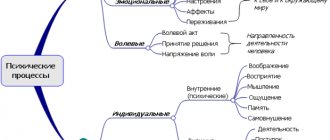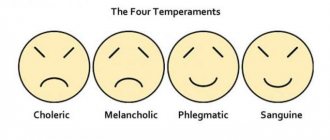Many psychologists have already confirmed that our drawings can tell a lot about our personality, character and mood. It is no coincidence that in both psychology and psychiatry many diagnostic methods are associated precisely with drawings. Particular attention is paid to children's drawings. When analyzing the personality of an adult, you can use the drawings that he makes casually - we all often move a pencil on paper during telephone conversations, meetings, lectures or long waits. From this article you will learn what our drawings can tell you.
Devil's Trident
However, there are times when we take symbols too directly and do not think about their true meaning. Many of us believe in urban legends that distort some real-life myths and beliefs. For example, many, especially believers, are sure that the symbol of psychology (Ψ) is the trident of the Devil.
This incorrect theory dates back to a time when people perceived mental illness as demonic possession. Mental disorders were believed to have supernatural causes such as spells and witchcraft, things beyond a person's control. This meant that everything was in the hands of the church and, of course, fate first. But nothing could be further from the truth than such an opinion. So let's look at the true origin of the psychology symbol.
What does the drawing tell you?
Psychological analysis of a person’s personality based on his drawings as a method of professional psychology arose at the beginning of the 20th century. Then the first tests appeared, the purpose of which was to diagnose various aspects of personality based on a person’s drawings.
Nowadays, psychologists have no doubt about the great importance of drawing in psychology, because drawing is the most important source of knowledge about the human psyche.
Psychological “decoding” of a drawing gives a qualitative idea of the personality of an adult; it is almost impossible to “fake” or predict the result, because the diagnosis and interpretation of a drawing is a complex and multi-layered process, somewhat similar to determining character from a person’s handwriting.
Doctor of Psychological Sciences, Professor Elena Potemkina conducted a large-scale psychological study from 1985 to 1995. This is an analysis and interpretation of more than 100,000 drawings that were made by people of different ages and areas of activity, who were in different life circumstances and mental states.
Thus, the professor managed to create a general model for analyzing a drawing, with the help of which it becomes possible to qualitatively diagnose and interpret the characteristics of a person’s psychology and determine his character from a drawing.
The table presents general signs by which individual personality traits can be determined.
General pattern analysis model
| Features of the drawing | Personality Features |
| -General appearance - proportions - color - dimensions - Location on the page - Composition of lines - Construction of the composition - Method of drawing - Presence of shading - Pressure force - Content of the image - Degree of its meaningfulness | -Self-esteem and general orientation of the individual -Degree of intellectual development -Characteristics of temperament -Emotional state -Development of imagination and fantasy -Peculiarities of motivation -Peculiarities of interpersonal relationships |
Psychological diagnostics using drawings in psychology is called projective diagnostics. This name is explained by the fact that in psychology a drawing is an individual projection of a person’s inner world, his character and personal characteristics. Psychology calls tests based on human drawings projective tests or techniques; they are of key importance among other techniques.
There are many interesting projective techniques, such as the “Family Drawing” or the “Nonexistent Animal” test, which can tell a lot about the character of the creator of the drawing.
What exactly do human drawings say?
You will learn about this through the example of the interpretation of the projective technique “Self-Portrait”.
Of course, a high-quality diagnosis should be carried out by a professional psychologist using a wide range of different methods, but you and I know how interesting it can be to independently “diagnose” yourself and your loved ones, to learn something new and interesting about yourself and others. You can find many different tests on the Internet, but are you sure of their authenticity and effectiveness?
That is why we bring to your attention a complete description of the professional projective technique “Self-Portrait” in the adaptation of the American researcher R. Burns with additions by E. Potemkina.
True story
In ancient Greek, the word psyche (as we mentioned earlier) meant butterfly. This insect was also a symbol of the breath of life and the life-giving wind. Gradually, thanks to the influence of the Roman Empire, the word turned out to be a symbol of the human soul. What the Greeks and Romans meant by the word "psyche" was our life force, also known as "ka" in Egyptian culture. All this, however, has a very indirect relationship to the question of what the symbol of psychology means.
The Greeks and Romans had a special view of the soul when it came to people. One of their beliefs was that when someone died, this "ka" that the Egyptians spoke of would leave their body, turning into an entity in the form of a clot of air. This clot then takes the shape of a butterfly. To the Greeks and Romans, butterflies symbolized light, change and hope.
Egyptian Key of Life Ankh
The Ankh (Coptic cross or knot of life) is known as an Egyptian hieroglyph that signifies eternal life, and life in the afterlife after death. It symbolizes the eternal life of the soul, which, after being released from the body, is able to open the entrance to the other world.
It is believed that the Egyptian Ankh cross is capable of transmitting the energy of the Universe to a person. This symbol of life has the meaning of power and longevity. Clears the energy background from troubles.
Connection with mythology
In Greek mythology, the word psyche means more than just a butterfly, the soul and the mind. Psyche was also a goddess, a beautiful creature with butterfly wings. Her love story is one of the most beautiful love stories of all time and was immortalized by Apuleius in the Metamorphoses.
According to history, among the three daughters of the King of Anatolia, there was a girl who was truly special. She was so delicate, attractive and full of joy that even Aphrodite herself began to envy her, seeing her as her rival. She was so desperately jealous that she immediately persuaded her son, Eros (Cupid), to hit her with his arrows. She wanted young Psyche to marry the most terrible, ugliest and heartless man in all of Anatolia.
Great love story
But things didn't go according to plan. Instead, it was her son, Eros, who fell in love with Psyche. Unable to stop, the young god decided to go to her room every night to conquer her and make her his. Psyche fell in love with a mysterious stranger who visited her every night. She didn't even see his face. The stranger was a god who wanted to keep his identity a secret.
But something went wrong. When Psyche told her sisters about this, they told her that she must break off the relationship until she saw the face of her mysterious lover. So she did. While Eros slept in her bed, she brought the lamp to his face. At that moment, the son of Aphrodite woke up and lost his temper, completely furious at Psyche's insolence.
Diagnostics in psychology “Drawing of a person”
Test “Drawing of a Person”
(Av: K. Makhover, F. Goodenough)
Scales: self-image, sociability, anxiety, aggressiveness, interpersonal relationships, body image, gender-role identity, developmental pathology, intelligence
Tested
Purpose of the test
A person's drawing is given different meanings. Some consider the image of the human figure to be a projection of the body image
, others
are a reflection of self-concept
.
It is taken as a projection of the child’s relationship to a significant person from his environment, a projection of the image of his ideal self, and an expression of habitual actions
.
It can be an expression of how a person perceives external circumstances, how he relates to life and society in general, or a combination of the above
.
Test Description
The “Human Drawing” test was developed by K. Makhover in 1946 based on the F. Goodenough test in order to determine individual personality characteristics.
Test instructions
The test procedure consists of giving the child a simple pencil of medium softness and a standard blank sheet of A4 paper (210 x 297 mm) and asking him to create a drawing: “ Please draw the kind of person you want.”
«.
If the child refuses, you must try to convince him. All kinds of questions, which, as a rule, are of a clarifying nature (“what kind of person?”), should be answered evasively, for example: “anyone”, “draw whoever you want.” To any expressions of doubt, you can say: “just start, and then it will be easier...”
In response to your request, the child will not necessarily create a full-fledged drawing of a person. He can draw a person partially, like a bust, or as a caricature, a cartoon character, or an abstract image. In principle, any drawing can provide important information about the child, however, if the drawing does not satisfy the requirements, the child is asked to take another sheet of paper and draw the person again, now in full size, with the whole head, torso, arms and legs.
The instruction is repeated until a satisfactory drawing of the human figure is obtained. You should record all the child’s questions and remarks during the drawing process, the peculiarities of his behavior, as well as such manipulations as erasing elements of the drawing and additions. The same goes for drawing time.
Observations of the child made while working on the drawing will provide important information about his characteristics.
- How did he react to the task?
- Did he express resistance or a sharp refusal?
- Did you ask additional questions and how many?
- Did he express an urgent need for further instructions?
- If so, then in what way: did he declare it directly or was it expressed in his movements and behavior?
- Maybe the child boldly began to complete the task and did not express any doubts about his abilities?
- Or were his doubts and insecurities reflected in everything he did and said?
Such observations provide a lot of food for thought: maybe the child feels unprotected, he is anxious, restless, unsure of himself, doubtful, suspicious, arrogant, negativistic, extremely critical, hostile, tense, calm, trusting, curious, embarrassed , alert, impulsive, etc. and so on.
After the drawing is completed, ask the child if he has drawn everything, and then move on to a conversation that is based on the drawing and its features. During the conversation, you can clarify all the unclear aspects of the drawing, and through the attitudes, feelings and experiences that the child expresses during the conversation, you can obtain unique information regarding his emotional and psychological state. The conversation may include questions:
- Who is this man?
- Where does he live?
- Does he have friends?
- What does he do?
- Is he good or evil?
- Who is he looking at?
- Who's looking at him?
Other questions to ask your child to get as much information as possible:
- Do you know this person?
- Who does he look like, who does he resemble?
- Who were you thinking about when you were drawing?
- What is the drawn person doing, what is he currently doing?
- How old is he?
- Where is he located?
- What's around him?
- What is he thinking about?
- How does he feel?
- What does he do?
- You like him?
- Does he have bad habits?
- Does he have any wishes?
- What comes to your mind when you look at this drawn man?
- Is this person healthy?
- What does this person want most?
During this conversation with your child, you can ask him to clarify or comment on the unclear details, dubious or unclear places in the drawing. Also ask which part of the body, in his opinion, turned out best and why, and which part was the worst, why.
Another option for talking with your child is to ask him to make up a story about this person.
Interpretation of test results
Short version of graphical information processing
The answers to the questions below will make it clear whether the child is showing any obvious deviations or whether there are signs of psychopathology.
Evaluate the child’s drawing on the following points:
- A man's head is drawn.
- He has two legs.
- Two arms.
- The body is sufficiently separated from the head.
- The length and width of the body are proportional.
- The shoulders are well drawn.
- The arms and legs are connected to the body correctly.
- The junctions of the arms and legs with the body are clearly highlighted.
- The neck is clearly visible.
- The length of the neck is proportional to the size of the body and head.
- The man's eyes are drawn.
- His nose is drawn.
- The mouth is drawn.
- The nose and mouth are of normal size.
- The nostrils are visible.
- Hair is drawn.
- The hair is drawn well, it evenly covers the head.
- The man is drawn in clothes.
- At least the main parts of the clothing (trousers and jacket/shirt) are drawn.
- All clothing shown other than the one above is well drawn.
- Clothing does not contain absurd or inappropriate elements.
- Fingers are depicted on the hands.
- Each hand has five fingers.
- The fingers are fairly proportional and not too spread out.
- The thumb is quite well defined.
- The wrists are well drawn by narrowing and then widening the forearm in the hand area.
- The elbow joint is drawn.
- The knee joint is drawn.
- The head has normal proportions in relation to the body.
- The arms are the same length as the body, or longer, but not more than twice as long.
- The length of the feet is approximately 1/3 of the length of the legs.
- The length of the legs is approximately equal to the length of the body or longer, but not more than twice.
- The length and width of the limbs are proportional.
- The heels of the legs can be seen.
- The head shape is correct.
- The body shape is generally correct.
- The outlines of the limbs are conveyed accurately.
- There are no gross errors in the transmission of the remaining parts.
- The ears are clearly distinguishable.
- The ears are in place and of normal size.
- Eyelashes and eyebrows are drawn on the face.
- The pupils are positioned correctly.
- The eyes are proportional to the size of the face.
- The person looks straight ahead, his eyes are not squinted to the side.
- The forehead and chin are clearly visible.
- The chin is separated from the lower lip.
It is very easy to draw conclusions. In general, the child’s drawing should correspond to the description given. The closer his drawing is to this model, the higher the level of his development. Give each positive answer one point and add up the points. A normally mentally developed child should score the points indicated below in accordance with his age.
- 5 years – 10 points.
- 6 years – 14 points.
- 7 years – 18 points.
- 8 years – 22 points.
- 9 years – 26 points.
- 10 years – 30 points.
- 11 years old – 34 points.
- 12 years old – 38 points.
- 13 years old – 42 points.
- 14 years old – over 42 points.
Additional details of the drawing, such as a cane, briefcase, roller skates, etc., speak in favor of the child, but provided that this detail is appropriate in the given drawing or even necessary for the given person depicted, for example, a sword for a warrior.
There may also be negative signs
, which you should pay attention to as they may indicate certain problems.
- There are no eyes on the face; one eye on the face in full view; two eyes on the face in profile.
- There is no nose, the nose is in the form of one vertical line or point.
- No mouth or one-dimensional mouth as a horizontal line.
- No torso or stick torso.
- There are no hands (the figure has one hand in frontal view), no fingers.
- Brushes in the form of mittens, stub brushes or fingerless circles.
- No feet.
- There are no clothes and no sexual characteristics.
- The shin is wider than the thigh and other violations of body proportions.
First of all, note whether there are gross errors in the image of the figure, for example, those listed above. If we assume that the drawing of a human figure symbolizes the image of the body
, which is considered very susceptible to external stimuli that disrupt the emotional state of the child, then the drawing will symbolically reflect the problems that he is experiencing.
The more significant the child's disorder, the more both his body image and his graphic representation of the latter suffer. Following the body image, the child’s drawing may suffer in whole or in part, or simply become slightly different from the generally accepted one. Serious deviations include the depiction of a figure with disparate body parts, completely inappropriate details, the depiction of another object instead of a person, the erasure of a drawn human figure, rigid, motionless, robot-like or very bizarre figures. Such cases indicate serious problems and disorders.
Another significant negative factor is the child’s depiction of a figure of the opposite sex.
, which is not necessarily associated with homosexual tendencies, as is often believed. It may be an expression of sexual role confusion, a strong attachment or dependence on a parent of the opposite sex, or a strong attachment or dependence on some other person of the opposite sex.
Symbolic meanings of the human figure
Each part of the depicted figure acquires a special symbolic meaning, since it reveals echoes of the emotional and social life of the child.
When interpreting this test, hasty conclusions are unacceptable. Research shows that the ways and manner of expressing emotions, experiences, conflicts and other aspects of a child’s mental life change depending on the situation and vary from person to person. Therefore, there is no need to make any diagnosis based on a single sign; in the process of analysis, it is necessary to take into account the drawing as a whole.
Head, forehead
The personification of the sphere of intellect, the place of localization of the child’s “I”, his mental center, therefore it is not surprising that maximum attention is paid to the head.
If the child pays little attention to his head
- this may indicate problems of adaptation to the social environment, communication difficulties, or even the presence of neurosis, since the head and, in particular, the forehead are also a reflection of self-control and the sphere of social contacts. This is the part of the body that is always open to the gaze of others and through this is involved in the process of relationships with other people.
No forehead
means that the child deliberately ignores the mental sphere. The ratio of the proportions of the head and body is the relationship between the physical and spiritual in the child.
If a person has a disproportionately large head
– this may be a sign that the child is suffering from headaches or other negative effects in this area. Fixation on the head may be associated with weakening of intellectual abilities or control, as a result of which the importance of this part of the body for the child increases. A large head in this case acts as an expression of the desire to compensate for what is missing. Teenagers who are aware of their lag behind their peers in mental development, in the development of reading or writing skills, etc., or who suffer from adaptation disorders, also often draw a large head on a person.
Hair
Highlighting hair on the head may indicate a desire to emphasize the masculinity of a male figure.
Emphasis on girls' hair, careful depiction of voluminous hairstyles, long, cascading
hair in combination with other obvious elements of decoration may indicate early sexual maturation.
Face
A symbol of the sphere of communication, the most important center of communication. It is considered to be the most social part of the drawing.
A child who has difficulty communicating, is timid, tends to avoid problems associated with conflicts in relationships with others, depicts facial features unclearly, draws them poorly, depicts them very schematically
,
misses the image of facial features
. At the same time, he can carefully and confidently highlight other parts of the figure.
Another indicative case is when a child draws his face last.
. The relationships of such a child are very superficial; he tolerates other people to the extent that he can. He is extremely wary, expects only bad things from others, and is often hostile towards others.
We can also talk about aggression and hostility in the case of an appropriate facial expression: wide eyes, pursed lips or an open mouth with bared teeth.
.
Well-drawn facial features
They talk about self-attention and healthy self-esteem. On the other hand, focusing on this part, excessively emphasizing and highlighting facial features may be an attempt to create an image of a socially adapted, successful person with personal energy in order to compensate for one’s inadequacy and weakness of self-affirmation.
Painted face
– a rather negative sign that correlates with a loss of identity, a loss of a sense of self. An equally disturbing fact is the image of an animal-like or robot-like face, as well as an impersonal, expressionless face, which can be said to be inanimate.
Chin
It has a stereotypical meaning, according to which we know that the chin is a reflection of willpower, authority, masculinity, etc.
Preoccupation with the image of the chin, which manifests itself in the fact that it is often erased, redrawn, outlined, or drawn noticeably protruding
(in the pictures the figure is in profile) can be regarded as compensation for weakness, indecision, and fear of responsibility. This may indicate a desire for superiority and importance in the eyes of others.
This interpretation is even more justified if the strong, pressing drawing of the entire facial profile is combined with weak, light lines in the image of the remaining parts. In this case, we can assume that the author of the drawing actually does not possess such qualities and only imagines himself as such in his imagination.
Brows
Eyebrows are given the same importance as the scalp.
Neat eyebrows
, just like a neat hairstyle, is evidence of caring about one’s own appearance, grooming, restraint, and moderation.
Thick, shaggy eyebrows
they talk about rudeness of character, obstinacy, intemperance, primitiveness of morals, etc. Raised eyebrows are associated with arrogance and arrogance.
Ears
If they exist, then they indicate openness of perception or wariness in relation to the world around us.
Children begin to depict ears at a fairly late age, so skipping or hiding this part of the body
hair is considered insignificant. A certain emphasis on the ears in the picture may indicate sensitivity to comments and condemnation and, indirectly, stubbornness and disobedience to authority.
Eyes
Eyes, as you know, are the mirror of the soul, a reflection of the child’s inner world. Just the look in the eyes can say a lot about a child: shy, dreamy, gloomy.
Intense, piercing gaze
- an expression of aggressiveness.
The eyes are large, with drawn pupils or without pupils with shaded sclera
– a symbol of fear or anxiety. Large and carefully drawn eyes are mostly drawn by girls and much less often by boys.
Eyes wide open
, but not exaggerated, can be a sign of curiosity. The gaze is not straight, but squinted, indicating suspicion.
Since with the help of our eyes we contact the world around us, in the case of small eyes
we can talk about secrecy, self-focus, preoccupation with one's own feelings.
Closed eyes
aza is an attempt to isolate yourself from the outside world, from contacts with others. The absence of pupils and empty eye sockets probably indicate extreme egocentrism, that the child does not find anything around him worthy of his attention.
Beautiful, symmetrical, well drawn
eyes are a reflection of the desire to be attractive and likable to other people.
Mouth
The mouth is a multi-valued element. If your mouth is open
, then this is considered to be a sign of aggression or verbal activity of an aggressive nature; if
teeth are drawn
, then this is obvious aggression. Perhaps it is protective in nature.
Selection of the mouth, which can be expressed in erasure, displacement, disproportionate sizes, underlining, etc., is generally typical for young children who, not so long ago, were in oral dependence on their mother. In older children, this already becomes a sign of dependence and lack of independence.
Mouth indicated by one straight line
, may indicate internal tension.
Lips
Lips are a generally accepted symbol of the sexual sphere. In children's drawings, lips are one of those details that convey the overall facial expression.
Plump lips
the figure drawn by a girl is a sign of correct gender identification.
Drawn lips in a drawing of a teenager
may indicate the presence of narcissistic tendencies.
Nose
The nose itself has no interpretive meaning. Often in connection with the nose, one recalls the psychoanalytic interpretation, in line with which it is considered a sexual symbol. Although practicing psychologists believe that a teenager experiencing sexual problems will most likely focus on symbols such as a tie or trouser pockets, rather than on the nose. The absence of a nose may indicate some degree of intellectual disability.
Neck
The neck is the connecting link between the body (symbol of animal passions, impulsive life) and the head (intellectual center, mind, control).
The neck area is given attention by those who are concerned about the relationship between bodily impulses and conscious control. Such people are not sure that they can always cope with their impulses. They are characterized by a state of certain duality.
Long neck
associated with a clamped, constrained, moralizing, mannered person who has good self-control.
Short neck
can symbolize naturalness, straightforwardness. The absence of a neck in children's drawings is a sign of immaturity.
Hands, palms, fingers
Hands are a symbol of activity, communication and contact. If a person's arms are spread apart
, as if for a hug, extended towards the environment - this is a sign of sociability, active interaction with the outside world.
If, on the contrary, the hands are hidden behind the back, hanging sluggishly along the body, pressed tightly to the body, the palms are hidden in the pockets
- this may indicate unsociability and isolation. In combination with other features of the drawing, this may be a sign of withdrawal, narcissism and vanity, or strong internal tension.
Another important characteristic of the image of hands is their tone. Flexible, mobile, free-standing arms
, probably indicate good social adaptability, ease of establishing contacts with the environment, and active integration into the environment. Rigid, inflexible, mechanically outstretched, bent at right angles arms can characterize superficial and unemotional contacts with the outside world.
Large, large palms
is a sign of an active, explosive character, while the absence of palms indicates inability, lack of faith in one’s strength, and a feeling of unfitness. Poorly drawn palms indicate insufficient contact, a limited scope of communication and low productivity in practical activities. Carefully drawn fingers mean the ability to control the situation, hold it in your hands, and manage it.
Long fingers with nails or emphasizing fists
- a sign of aggression, belligerence. Fists on the hand away from the body - open hostility, rebellion, confrontation. If hands with clenched fists are pressed to the body, we can talk about a hidden, suppressed tendency to revolt. Fingers depicted as if the person is ready to grab something, like the claws of a bird of prey, can indicate aggression. Other possible symbols of hostility: hands raised, painted hands.
No hands
– extreme degree of passivity, inactivity, unsociability, timidity, intellectual immaturity. In combination with such features of the design as the absence of a mouth, the absence of a torso and the general grotesqueness of the design, the absence of hands indicates a poor adaptation of the child.
For older children, the absence of arms is a very unusual fact. In addition, this may express the feeling of guilt that the child experiences in connection with his aggressive, hostile attitude. Heavily shaded hands can mean the same thing.
.
Short arms
may indicate isolation, turning inward, on oneself, and the desire to keep oneself within certain limits, not allowing one’s impulses to manifest themselves.
If a child draws long arms
- this speaks of an orientation towards the outside world, contact, the desire to acquire, accumulate.
Big, muscular arms
They are drawn by children who recognize the priority of strength, who strive to become physically strong; large and strong hands also appear in the drawings of those who are trying to balance and compensate for their own weakness in this way. On the other hand, a child who is aware of his weak physical condition can depict thin, fragile hands.
Torso
The torso is a symbol of the child’s idea of the physical appearance of a person.
A strong, muscular body drawn by a fragile, weak child
- this is a sign of compensation for the missing, ideal physical appearance for him.
A large, strong body with powerful shoulders in a drawing of a child of normal build
– inner strength, strong ego.
Broad, massive shoulders
serve as an expression of physical strength and superiority. Teenagers experiencing sexual inadequacy may express this in their shoulders, which are very prominent in relation to other parts of the body.
If a strong child draws a weak body
, then perhaps this is due to some experience from past experience. A fragile body can be an expression of one's own weakness. A child who seeks to indulge his desires and ignores any manifestations of self-control may draw a weak, limp body with a disproportionately small head.
If a small child depicts a navel
- this is a sign of egocentrism, if the navel is drawn by an older child - this becomes an expression of immaturity or a desire to withdraw into oneself.
Overall rounded body shape
- balance, calmer character, some femininity. An angular, rectangular figure is associated with masculinity, energy and expressiveness.
Often the figure is decorated with additional accessories
(bows, buckles, etc.). This means increased attention to one’s own person.
An extremely negative sign is the image of the insides of the body
. It indicates serious mental disorders.
Legs
Legs are a symbol of support, stability, and practical orientation.
If the feet are drawn in profile
- This is a sign of stability and self-confidence.
Feet with toes facing the observer or no feet
express feelings of uncertainty.
teenagers separating the lower half of the body with a bold line in the drawing
, can thus express the presence of problems related to the sexual sphere.
Weak, short, poorly drawn or shaded legs
- an expression of uncertainty, weakness, one’s own worthlessness, loss of spirit.
If the feet of a dressed person are depicted with toes
, then this may indicate extreme aggressiveness.
Small, unsteady feet
– a fairly common feature in the drawings of children experiencing a feeling of insecurity. Such children draw unstable figures, ready to fall at any moment due to the extremely weak stability of their tiny feet. The child unconsciously expresses in symbolic form the instability of a personality built on a weak, unreliable foundation. In the absence of a basic sense of security, personality development is impaired; Constant anxiety continues to hinder progress toward emotional maturity and mental health.
Genitals
Hiding the genital area
often found in drawings by teenage girls. The female figure's arms are depicted shyly covering the lower abdomen, while the male figure's arms are boldly spread to the sides. One girl drew a picture of a bride holding a bouquet over the center of her body. Other objects may also be depicted above the lower abdomen.
Explicit depiction of genitals
. The depiction of the genitals is so unusual that their presence in the drawing can be very significant. The refusal to reproduce genitals does not appear to be due to a cultural taboo. A more likely explanation may be a shift in interest from one’s body to the fascinating world around us, which is typical for the behavior of children during the period of hidden sexuality.
Between the ages of six and twelve, well-adjusted children become more and more involved in learning new skills and doing things that are in keeping with the habits of their schoolmates and friends. Drawings by children of the period of hidden sexuality in which the penis or vulva are depicted openly are very rare. The reasons for this unusual addition must be sought in cases which involve precocious children aware of the high emotional value invested in the genitals. Hernia surgery or circumcision after infancy can cause castration fears. Seduction by older children or adults or more subtle maneuvers can arouse a child during a period of latent sexuality, especially a bright, sensitive child. Whatever the reason for those rare cases of open depiction of genitals - and in most cases these were behavioral disorders of one kind or another (aggression, phobias) - this did not prevent children from developing and adapting well when reaching adolescence.
Position and size of the picture
Since the drawn figure is considered to be closely related to the author of the drawing and characterizes him in a certain way, the interpretation should cover as many features of the drawing as possible. Aspects of a drawing of a person, such as the size of the figure, its pose and placement on the sheet, the quality of the lines (pressure, hardness, duration or discontinuity), the sequence of details, the use of background or background effects, and extraneous objects
, represent significant aspects of the child’s self-image and are also analyzed.
The proportions of the body parts of the figure
, the presence of unfinished elements of the drawing, the level of detail drawing, the presence of strong pressure and its localization, erasing, making changes to the drawing, emotions expressed on the person’s face and in his posture are taken into account.
Size and location
Feeling insecure, anxious children tend to draw small figures
, which modestly occupy only a small area of available space. A small figure can indicate depression and a feeling of inadequacy. In contrast, well-adjusted children with a strong sense of security draw freely and easily, creating designs that, through their size, scope, and conspicuous placement on the page, express freedom from anxiety and worry.
Excessively large, bulky figure sizes
, apparently, express weak internal control and expansiveness.
Bent figure
may reflect a lack of mental balance, instability.
A figure shifted to the right on the sheet
, speaks of an orientation towards the outside world,
a shift to the left
means an emphasis on oneself.
If a child occupies mainly the upper part of the sheet
, it means that he is prone to optimism.
The feeling of depression and depression is often reflected in the location of the figure at the bottom of the sheet
.
A large, boldly drawn figure placed in the center of the sheet
, speaks of inflated self-esteem.
If a child draws a line to the ground and positions the person high from it
, so that he seems to be floating in the air, then he is probably characterized by isolation from reality, a penchant for fantasy and games of imagination, and weak contact with reality.
Perspective
Boys (rarely girls) of adolescence sometimes depict a person with their body in front and their head in profile
. This unnatural position of the figure is usually considered a sign of social tension. In addition, this may be a sign of a certain sense of guilt associated with the sphere of communication. If this position - head in profile, body in front - is aggravated by the image of the legs in profile, then in this case we can talk about low mental development and impaired spatial imagination.
Other Image Features
Transparency effect
(the ability to see one detail in a drawing through another).
The presence of transparent elements in a drawing can be a completely natural factor if the drawing was made by a 6-year-old child.
At an older age, this may already have a negative meaning, since the transparency of details contradicts reality. We can talk about either a slight developmental delay or more serious disorders, such as personality disorganization or mental retardation. In a “soft” version, transparency may also indicate that the child feels deprived of support and protection. The negative value of transparency is assessed by the number of transparent elements and the size of the transparent part (the second case seems to be more indicative).
Optional Details
Among the optional details of the design are such as a cigarette or pipe, a weapon, a cane, buttons, pockets, and a hat. Weapon
in the hands of a drawn figure is interpreted as a sign of a hostile, aggressive attitude.
Buttons
in the drawings of older children may indicate a lack of maturity and immaturity.
The same thing seems to be evidenced by the allocation of pockets
.
The emphasis on elements such as a bow tie and a hat
is generally believed to have sexual overtones.
Other sexual symbols are a pipe, a cigarette and, less commonly, a cane
.
Swelling of the fly on trousers
can be observed in teenagers who are preoccupied with masturbation.
Scattered body parts
Such cases undoubtedly indicate a deviation, since the vast majority of children, even from their earliest attempts to depict a person, draw an integrated figure. A drawing of a person in which parts are scattered without regard to each other is a clear deviation from the norm. This refusal to create a coherent drawing has been noted in children with serious disabilities and is an indicator of their personal disorganization.
Limited, ascetic, robot-like designs
Emotionally immature children draw limited, stereotypical figures. This disorder can take many forms, but the most typical for most children is a discrepancy between abilities and school performance. Many of them are quite bright, but are poorly receptive to academic pursuits. Often the origins of the problem can be traced back to a family situation marked by excessive tension.
Excessive shading
The emphasis on shading of the entire drawn figure or part of it can be observed in the drawings of anxious children. The shading may be limited to the face, lower body, or specifically the genital area.
Excessive, energetic shading, sometimes directed at the genital area, can be observed in the drawings of depressed, overly controlled junior schoolchildren, at an age close to the period of latent sexuality. For children who have passed this stage, that is, over the age of 13, who have reached an age when the child is prone to introspection and experiences anxiety about his abilities, such reactions are atypical. Incidents of shading in drawings may be indicators of emotional distress.
Drawings without people
Refusal to draw a person and depict inanimate objects must be considered as an unusual, possibly deviant act, suggesting difficulties in interpersonal relationships, abnormal indifference, emotional detachment, autism.
Dark clouds and shaded sun
Many well-adjusted children can illuminate a drawing of a human figure by adding a shining sun. Usually in one of the upper corners of the leaf, often in the shape of an arc. The lines emanating from the circle represent rays, and the sun may have a smiling face.
It's unusual for children to add rain clouds and shade the sun. These ominous signs have been seen in the drawings of unhappy, anxious, depressed children.
Erasing
Acts of erasure are considered an expression of anxiety and dissatisfaction. As a rule, erasures lead to deterioration rather than improvement of the drawing, thereby confirming that they serve as an expression of conflict.
Sources
- Family Drawing Test
/ Taylor K. Psychological tests and exercises for children. A book for parents and educators - M., 2005.
Descent to Hades
Mad, desperate and frustrated, the daughter of the King of Anatolia went to Aphrodite to ask for help. Eros's mother saw this as an opportunity to gain the upper hand over her. She saw Psyche's visit as a chance to rid the world of this girl who dared to compete with the goddess of beauty. She gave her four tests that Psyche had to pass in order to earn the love and forgiveness of Eros. But the trials included entering the underworld, meeting Cerberus, traveling with Charon, and then talking to Hades to eventually get to Persephone and ask her for some special beautiful thing that she kept in a small box. Her story reminds us of the deep meaning of the graphic symbol of psychology.
Against all odds, the quick-witted Psyche has proven that she is not only beautiful. She was smart, brave and determined. But when she completed each task and received the Persephone box, she was overcome by vanity and curiosity. She decided to open the box to see what was inside and take for herself this mysterious beautiful object that was kept there. And after that she immediately went blind. Fortunately, Eros came to her aid, forgave Psyche, and cured her of blindness. This story is often mentioned in the context of symbols in psychology subjects.
Structure
All symboldrama sessions, regardless of type, follow the same scenario. Stages:
- Preliminary conversation - the patient talks about himself, the problem, expectations, feelings, emotions (20 minutes).
- Relaxation - put into a relaxed state, usually lying on the couch (5 minutes).
- Presentation of images (from 5 to 40 minutes - depending on the severity of the situation).
- Discussion of the presentation (10 minutes).
After the patient leaves, the psychotherapist still has a lot of work to do. He must analyze what happened in the session. Typically the images presented are characterized as:
- immature archaic with pre-ambivalent properties;
- more mature with already ambivalent and ambient properties;
- oedipal;
- latent and adolescent;
- mature.
Based on the analysis, images and the most effective work techniques are selected for the next session.
The complexity of symbolism
Not all images are necessarily symbolic. We can appreciate them as beautiful pictures without any particular interpretation suggested or required. However, the symbolism certainly makes them interesting, especially for people who like to find meaning in various things and phenomena.
Simply, a certain symbol is something that represents, denotes or points to something else, hidden from view, invisible at first glance. Most people are familiar with the idea of dreams containing symbols. Many are also familiar with the idea of "interpreting" dreams. Actually, dreams are images. Any image, even if it's just a picture in your head, can be symbolic and open to interpretation.
Interpretation of research results
To derive a hypothesis and determine the exact meaning of a phenomenon, research is carried out. They are aimed at studying, identifying patterns, and making accurate forecasts. Thus, hypotheses gradually turn into true knowledge, which is scientifically confirmed. And after each study, an interpretation is carried out, that is, an analysis of the data obtained.
Since there are cases when specially organized conditions lead to a different, unplanned result, numerous studies are carried out here to understand what influences the change in results, which is also interpreted and inferred as true knowledge.
The following types of research are distinguished:
- Genetic – when the evolution of the genetic component is studied over a long period of time.
- Structural – when the structural components of a subject are explained. Long-term observations are made here to detect various changes.
- Functional – when the dynamics of the development of a phenomenon are observed in order to determine connections with the environment, influence, etc.
- Complex - when the subject is studied at various levels.
- Systemic – when individual components that make up a single system are studied.
go to top
Symbols and images in psychology
Some symbols are quite universal. Many people from different cultures around the planet assign the same meanings to the same symbols. Water symbolizes birth, purification and rejuvenation. The house represents the self, the self, the personality, the ego. The circle indicates unity and eternity. Carl Jung, the famous psychological theorist, called these images “archetypes.” They represent universal patterns of human thought that reside in our collective unconscious. Instinctively we react to these images, although we may not always be aware of this reaction. Some of these symbols stem from pagan beliefs about nature. Others may have evolved from the most basic elements of human psychology, culture and spirituality. One way or another, decoding symbols in psychology is a very exciting activity.
Interpretations of symbols can also be unique. People from different cultures and backgrounds can, among other things, assign different meanings to symbols. For example, colors, which can be highly symbolic, vary in meaning from one culture to another. In one culture, black may be a color associated with death; in another, the color of death may be white. People can also have their own personal symbols based on their unique personality and history. If you saw a small bird die next to a rose bush, you may associate roses with death.
The meaning of drawings depending on color
Adults mostly draw black and white drawings, but children can draw color drawings. Therefore, it is most clearly possible to analyze and evaluate children's works.
Color
- Green is the color of independence, independence and perseverance. Children who are trying to show their full character and assert themselves choose this color.
- Yellow - the baby feels comfortable in this situation.
- Blue – characterizes anxiety and excitement. This color indicates that the child has some kind of problem that he is trying to solve.
- Violet is a child who is a dreamer.
- Red color - indicates an excess of energy that needs to be released as quickly as possible. This applies to hyperactive children. Red is the color of aggression.
- Brown means resistance on a subconscious level. The baby may be worried about some situation and therefore feels anxious and uncomfortable.
- Black - indicates concern about some problem. He is completely immersed in the problem.
- If an adult’s drawing is shaded , it means closed. A person constantly puts himself in limits.
- Unshaded figures mean a person constantly wants to develop, and perceives all changes with joy.
Associations in psychology
Symbols are responsible for the most ancient and basic type of thinking known as “association.”
One way to discover possible meanings for a symbol is through free communication. When you see a particular element in an image, what does it remind you of? It’s the same with the symbol of psychology - it evokes a variety of associations, but has a clear symbolic meaning that we perceive on an unconscious level.
Things get a lot more complicated, and a lot more interesting, when the image contains many possible symbols. In this case, we have images interacting with symbols, meanings interacting with meanings. And not only do the elements of the images interact with each other, but also the tones, colors and compositions that allow even more maneuver for interpretation.
Analysis of the location of a drawing on a sheet of paper
It is very important how much space a child’s drawing occupies on a sheet of paper. The child, satisfied with his position, places the drawing in the center of the sheet. He feels comfortable and harmonious. A child who is timid and unsure of himself depicts the details of the drawing as small. A small drawing accordingly speaks of the child’s low self-esteem. If the drawing is located in the center of the sheet, but in size it occupies almost the entire space, then we can talk about the child’s inflated self-esteem and his desire to take up even more space.
Also pay attention to the placement of the picture vertically from the center. An upward shift indicates a desire to dominate and control the situation. If the drawing is shifted downwards, the child is passive, dependent on the environment and unsure of himself.
Shifting the picture to the right indicates the child’s desire for the future. This pattern is typical for extroverts who are active, decisive, and whose intellect predominates over the emotional sphere. Introverts live more in the past, so they often draw on the left. Such a child is very emotional, he is a dreamer by nature, he wants to remain small.









